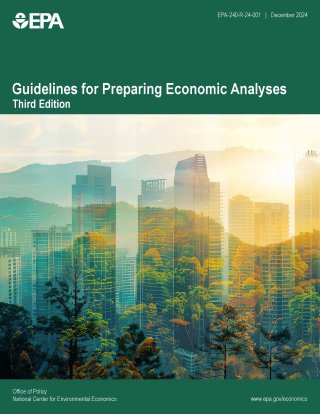Guidelines for Preparing Economic Analyses, 3rd Edition

Download: Guidelines for Preparing Economic Analyses, 3rd edition (pdf) .
Suggested citation: U.S. EPA. 2024. Guidelines for Preparing Economic Analyses (3rd edition). Report number EPA-240-R-24-001. Washington, DC.
On this page:
- What are the Guidelines?
- Why are the Guidelines important?
- What topics are covered in the Guidelines?
- Who are the Guidelines for?
- How were the Guidelines produced?
- How will future updates to the Guidelines be incorporated?
- Download individual Guidelines chapters.
What are the Guidelines?
EPA's Guidelines for Preparing Economic Analyses establish a sound scientific framework for performing economic analyses of environmental regulations and policies. They incorporate recent advances in theoretical and applied work in the field of environmental economics. The Guidelines provide guidance on analyzing the benefits, costs, and economic impacts of regulations and policies, including assessing the distribution of costs and benefits among various segments of the population.
Why are the Guidelines important?
The Guidelines serve several important functions, including:
- Providing analysts with information needed to prepare high quality economic analyses.
- Developing an overarching framework for economic analyses throughout the Agency and across EPA Program Offices.
- Ensuring that important subjects such as uncertainty, timing, and valuation of costs and benefits, are treated consistently in all economic analyses at the EPA.
The EPA will use the Guidelines to evaluate the economic consequences of its regulations and policies.
What topics are covered in the Guidelines?
The Guidelines address major analytical issues on key topics, including:
- Estimating the value of reduced health risks and improved environment quality.
- Defining baseline conditions (i.e., contrasting the state of the economy and environment with and without a proposed regulatory policy).
- Selecting the appropriate framework for estimating the economic costs of improving environmental quality
- Discounting and comparing differences in the timing of benefits, costs, and impacts.
- Assessing and describing who pays the costs and receives the benefits of regulations.
- Locating available data sources for conducting economic analyses.
- Presenting the results of economic analysis, including information on impacts unable to be monetized.
Who are the Guidelines for?
The main audiences for the Guidelines are those performing or using economic analysis, including analysts in the Agency's Program and Regional Offices, and contractors providing economic reports to the EPA. However, the Guidelines may also be useful to policy makers to better understand the structure and limitations of the analyses, the public to increase understanding of the analyses, and to those teaching courses on benefit cost analysis or environmental economics.
How were the Guidelines produced?
Development of the Guidelines is led by the EPA's National Center for Environmental Economics (NCEE) in consultation with economists from across the Agency. All chapters undergo an external peer review prior to finalization, either through the EPA’s Science Advisory Board (SAB) or through independent reviews by external experts.
- Chapters 1 through 11 were reviewed in 2020 by the SAB’s Economic Guidelines Review Panel – a 12-member panel of experts from major universities and research institutions across the country.
- Chapter 10 contains content from the Second Edition of the Technical Guidance for Assessing Environmental Justice in Regulatory Analysis that was reviewed by an SAB panel of experts in 2024.
- Appendix A and B were reviewed by the SAB’s Environmental Economics Advisory Committee in 2009 and have not been substantively updated since that review.
- More information about the most recent peer review can be found here: www.epa.gov/sab.
NCEE will continue to update chapters of the Guidelines as warranted and as the science evolves. New chapters and updates to existing chapters will be peer-reviewed prior to finalization.
How will future updates to the Guidelines be incorporated?
EPA intends to revise and update these Guidelines periodically to capture new literature and the best available science. As new chapters are developed or existing chapters revised, they will be made available for download on this website once they pass external peer review.
Read the 2016 revision of the Guidelines for Preparing Economic Analyses, 2nd edition.
Download individual Guidelines chapters.
Download the Guidelines for Preparing Economic Analyses, 3rd edition (pdf) as a as a single PDF, or download individual chapters (all PDF documents) below.
- Cover (pdf)
- Table of Contents (pdf)
- Chapter 1: Introduction (pdf)
- Chapter 2: Statutory and Executive Directives for Conducting Economic Analyses (pdf)
- Chapter 3: Need for Regulatory Action and Evaluation of Policy Options (pdf)
- Chapter 4: Regulatory and Non-Regulatory Approaches to Environmental Policy (pdf)
- Chapter 5: Setting the Foundation: Scope, Baseline and Other Analytic Design Consideration (pdf)
- Chapter 6: Discounting Future Benefits and Costs (pdf)
- Chapter 7: Analyzing Benefits (pdf)
- Chapter 8: Analyzing Costs (pdf)
- Chapter 9: Economic Impacts (pdf)
- Chapter 10: Environmental Justice and Life Stage Considerations (pdf)
- Chapter 11: Presentation and Analysis of Results (pdf)
- Appendix A: Economic Theory (pdf)
- Appendix B: Mortality Risk Valuation Estimates (pdf)
- Glossary (pdf)
For more information on the Guidelines, contact Nathalie Simon (Guidelines Project Leader) at 202-566-2347 or [email protected], or Alex Marten (Acting NCEE Director) at 202-566-2244, [email protected].
